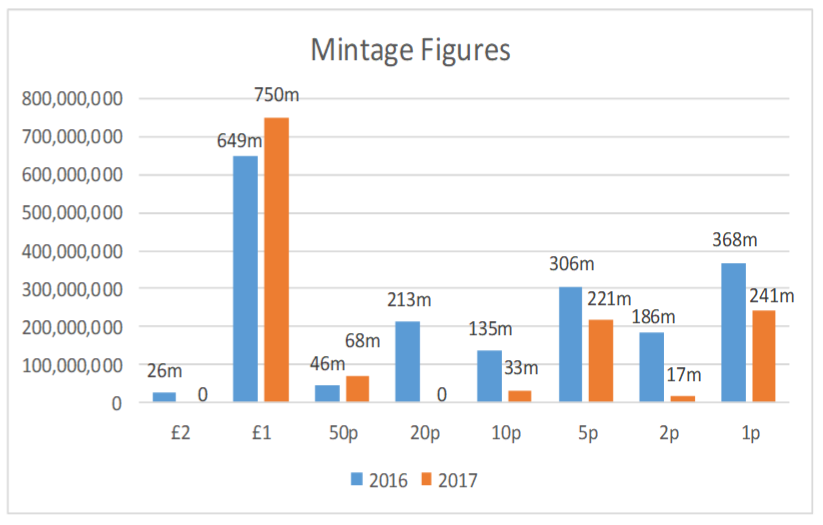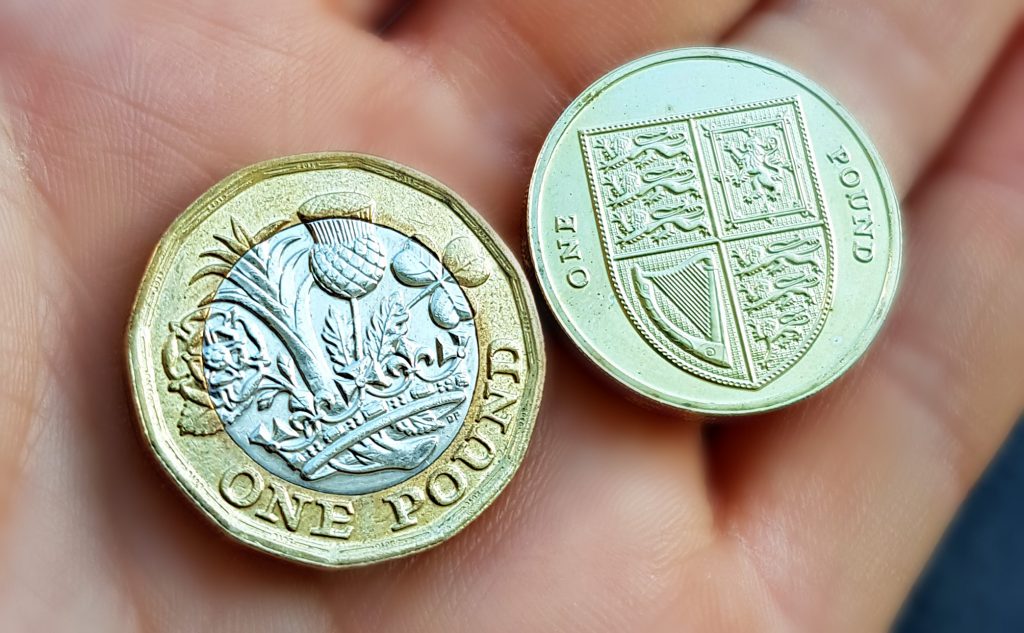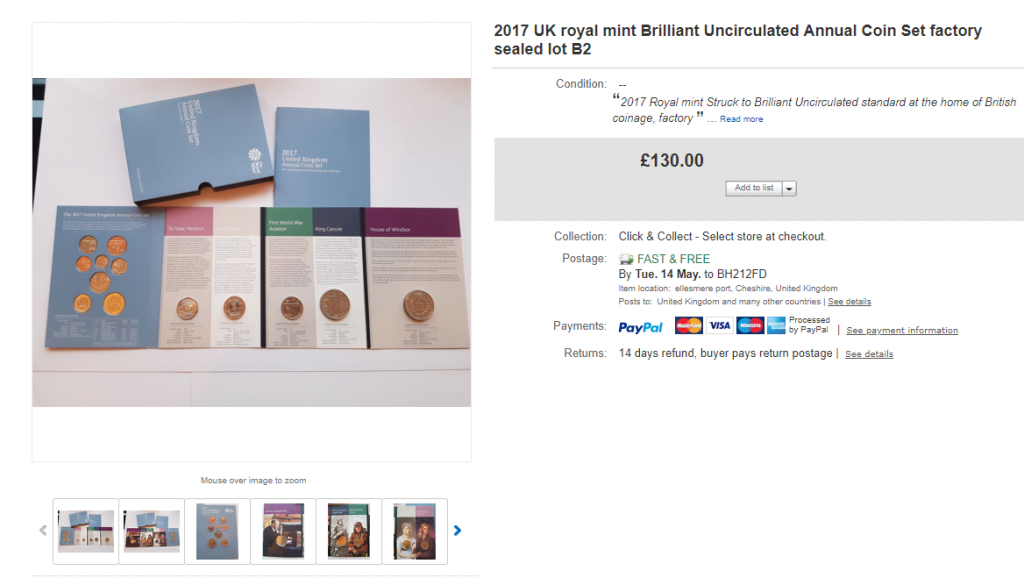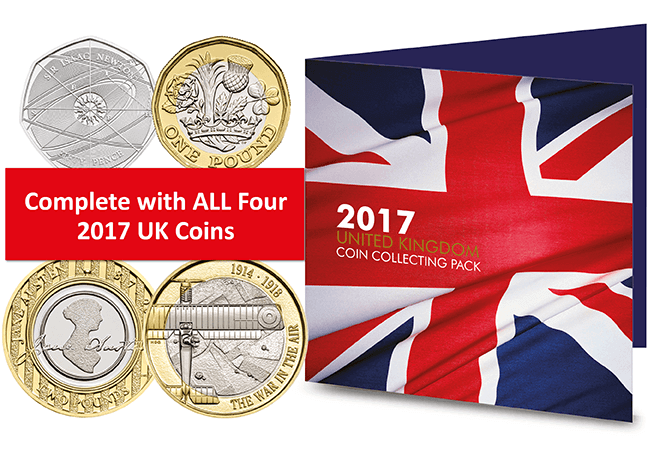1 pound coins
Discovering the UK’s Definitive Coin Designs
We’re celebrating the unsung heroes of the coin collecting world by taking a deep dive into the UK’s definitive coin designs.
From the 1p to the £2 coin, find out all you need to know about the definitive coins that have been issued over the last 51 years…
£2
1997-2015: History of Technology £2

In 1997 a new type of £2 coin was introduced which featured an innovative bi-metallic design and was the first in the history of British coinage.
Previously, £2 coins had been issued as commemoratives only and featured a single metal design.
The reverse of the new bi-metallic coin shows Bruce Rushin’s representation of mankind’s technological evolution from the Iron Age. The concentric circles each denote a different technological milestone, including the Industrial Revolution, the computer age and the age of the Internet.
The obverse features a portrait of Queen Elizabeth II by Ian Rank-Broadley.
2015 – Present: Britannia £2

In 2015, the “History of Technology” design, which featured on the £2 coin since 1997, was replaced by the introduction of an iconic Britannia design by Anthony Dufort.
Britannia first appeared on British coins in 1672 and subsequently featured on a British coin in one way or another for more than 300 years. In 2008 she was surprisingly dropped from the 50 pence piece despite a Daily Mail campaign to save her, and so her appearance on the definitive £2 coins in 2015 was a triumphant return.
The obverse features Jody Clark’s portrait of Queen Elizabeth II, which is the 5th portrait of Her Majesty to appear on a coin.
So far there have only been issues of this coin in 2015 and again in 2016, however just 650,000 Britannia £2s were issued in 2015, making it the joint 3rd rarest £2 in circulation.
£1
2008-2016: Royal Arms

The first UK £1 coin was issued in 1983 to replace the £1 banknote, which was only lasting a few months in circulation.
It was struck from Nickel-brass, making it yellow in colour, and it was much thicker than the other coins in our change.
£1 coins were initially issued in recurring five year programmes including series of designs representing the UK and the home nations.
It wasn’t until 2008 that the first official definitive £1 coin was issued.
The reverse design was created by Matthew Dent, who won a public competition to redesign the UK’s definitive coinage.
His concept was based on the Royal Shield of Arms and this £1 coin features the complete shield – representing the United Kingdom as a whole.
The obverse design featured the 4th portrait of Queen Elizabeth II, by Raphael Maklouf until 2015, when this was replaced by Jody Clark’s design.
2016 – Present: Nations of the Crown

To combat counterfeiting, a new bi-metallic, 12-sided £1 coin was introduced in March 2017.
Billed as the most secure circulating coin in the world, the new £1 coin was designed by 15-year-old David Pearce following a public competition in 2015.
The new design is made up of the English rose, the Welsh leek, the Scottish thistle and the Northern Irish shamrock emerging from one stem within a royal coronet to represent the four constituent countries of the United Kingdom.
The obverse features the 5th portrait of Queen Elizabeth II by Jody Clark.
50p
1969-1981: Britannia 50 New Pence

October 1969 saw the entrance of the 50 New Pence coin into circulation and its revolutionary heptagonal shape was the first of its kind.
Its reverse design, by Christopher Ironside remained traditional however, featuring the familiar and iconic image of Britannia.
Arnold Machin’s portrait of Queen Elizabeth II features on the obverse and this was the second portrait of Her Majesty to appear on a coin.
1982-1997: Britannia 50 Pence

In 1982 the UK’s definitive coin designs were updated, as they were no longer considered ‘new’.
The lettering of this 50p differs from its predecessor, changing from ’New Pence’ to ‘Fifty Pence’.
The 1982-1997 50p features Christopher Ironside’s image of Britannia, the allegorical female figure that symbolizes Britain on the reverse.
The obverse of this coin featured the 2nd portrait of the Queen by Arnold Machin until 1985 when it was replaced with the new portrait by Raphael Maklouf.
1997-2008: Britannia Fifty Pence

In October 1994, the Government reviewed the United Kingdom coinage and a requirement for a smaller 50 pence coin was revealed.
On 1st September 1997 a 27.3mm diameter 50 pence was issued; a 2.7mm reduction from the previous 50 pence.
The traditional image of Britannia remained on the reverse, designed by Christopher Ironside, as did the obverse portrait of Queen Elizabeth II, by Raphael Maklouf.
2008 – Present: 50p Royal Arms

In 2008, the UK’s previous definitive coin designs were replaced by Matthew Dent’s winning competition entry which saw all the definitive coins form a complete image of the Royal Shield of Arms when pieced together.
The 50p coin design completes the lower section of the Royal Shield and features the denomination in the lower segment.
In 2015, the obverse design was changed to feature the 5th portrait of HM Queen Elizabeth II by Jody Clark, replacing Ian Rank-Broadley’s portrait.
This design was issued every year from 2008 to present, excluding 2009, 2010, 2011 and 2016.
The rarest Royal Shield 50p was issued in 2017 and has a mintage of 1,800,000 – making it the second rarest 50p in circulation. Mintage figures for 2018 and 2019 coins have not yet been revealed.
20p
1982-2008: The Royal Badge of England

Introduced into circulation in June 1982, the 20 pence coin was giving the same curved heptagonal shape as the 50p but is much smaller, measuring at 21.4mm in diameter.
The reverse design of the Royal Badge of England was designed by William Gardiner and it features a royally crowned double rose in between the dated year.
From 1982 the obverse features the design of Queen Elizabeth II by Arnold Machin. This changed to Raphael Maklouf’s 3rd portrait of Her Majesty Queen Elizabeth II in 1985 and Ian Rank-Broadley’s 4th portrait in 1998.
This 20p was issued annually between 1982 and 2008, excluding 1986 and 2017 in which there was low demand.
2008 – Present: 20p Royal Arms

A new design for the 20p was introduced in 2008 as part of the re-design of UK coinage using Matthew Dent’s shield design.
When the six individual coins are placed together the designs join to form the complete image of the Royal Shield of Arms. The design of the 20p shows the far-right segment of the shield.
The 20p had previously included the date on the reverse, but the new design required the Royal Mint to produce a new die with the date on the obverse. However when the new coins were struck for circulation, the old die was accidentally used, meaning a batch was issued with no date on either side of the coin, making a very rare undated 20p error coin.
The obverse features the 4th portrait of Her Majesty Queen Elizabeth II by Ian Rank-Broadley. In 2015, a 5th portrait of Her Majesty Queen Elizabeth II was designed by Jody Clark and the 20p obverse was updated to feature it.
10p
1968-1981: 10 New Pence

In 1968 the 10 New Pence coin entered circulation to replace the florin as part of Britain’s conversion to a system of decimal currency.
The public was uncertain about using this new coin to start with, after generations of pounds, shillings and pence, meaning the Decimal Currency Board still needed to reassure suspicious Britons to go decimal.
Featured on the reverse was Christopher Ironside’s design, incorporating part of the Crest of England; a lion passant guardant royally crowned.
The 2nd portrait of HM Queen Elizabeth II by Arnold Machin is on the obverse.
1992-2008: 10 Pence (3rd portrait; small type)

On 30th September 1992 a reduced size version of the 10 pence coin was introduced into circulation and the older and larger version of the coin was withdrawn from circulation on 30th June 1993.
This 10 pence measured at 24.5mm, 4mm less than its predecessor.
Whilst the reverse design by Christopher Ironside, a lion passant guardian royally crowned, remained the same, the lettering changed from ‘New Pence’ to ‘Ten Pence.’
Raphael Maklouf’s portrait of HM Queen Elizabeth II features on the obverse of the coin.
2008 – Present: 10p Royal Arms

In April 2008, Mathew Dent’s competition winning design was adopted on the 10p coin.
The 10p is designed to depict the top left quarter of the Royal Shield of Arms, showing the lions passant from the Royal Banner of England.
On the obverse, HM Queen Elizabeth II’s 4th portrait, by Ian Rank-Broadley is featured.
This 10p was issued consecutively from 2008 to 2017 but HM Queen Elizabeth II’s 5th portrait by Jody Clark, only features on coins issued after 2015.
5p
1968-1981: Five New Pence

In April 1968, 5p coins were issued as a replacement for shillings in preparation for decimalisation in 1971.
These were released into circulation at the same time as the very first 10p coins.
The reverse, by Christopher Ironside, shows The Badge of Scotland and a thistle royally crowned.
The obverse features the second crowned portrait of HM Queen Elizabeth II, designed by Arnold Machin.
1990-1998: Five Pence- Reduced Size

In 1987 the Government announced its intention to issue a smaller 5p coin and on 27th June 1990 the new 18.00mm 5p was introduced.
The reverse design remained the same as the previous years’, with a royally crowned Scottish thistle, designed by Christopher Ironside but the words ‘Five Pence’ were written instead of ‘New Pence’.
From 1990 to 1998 the obverse design shows Raphael Maklouf’s portrait of Her Majesty Queen Elizabeth II and from 1998 to 2008 the obverse design shows Ian Rank-Broadley’s portrait of Her Majesty Queen Elizabeth II.
2008 – Present: Royal Arms

A new design for the 5p was introduced in 2008 as part of the re-design of UK coinage using Matthew Dent’s Royal Shield design.
The 5p coin depicts the centre of the Royal shield, showing the meeting point of the four quarters.
The obverse from 2008 to 2015 features the 4th portrait of Her Majesty Queen Elizabeth II by Ian Rank-Broadley and from 2015 to present features the 5th portrait of Her Majesty Queen Elizabeth II by Jody Clark.
2p
1971-1981: Badge of the Prince of Wales – New Pence

On 15 February 1971, the United Kingdom adopted a new decimal currency system and the 2p was introduced into general circulation.
The reverse incorporates the wording ‘NEW’ so to avoid confusion between the old and new coinage and features the badge of the Prince of Wales, designed by Christopher Ironside.
The obverse features Arnold Machin’s portrait of HM Queen Elizabeth II; her second crowned portrait to appear on a coin.
1985-1992: Badge of the Prince of Wales – Two Pence

In 1982, the reverse inscription on the 2p coin was changed from ‘NEW PENCE’ to ‘TWO PENCE’.
The reverse of the coin features the badge of the Prince of Wales with his motto ‘Ich Dien’ (I serve), designed by Christopher Ironside.
From 1982 the obverse shows the third portrait of HM Queen Elizabeth II, by Raphael Maklouf. This changed in 1998 when it was replaced by Ian Rank-Broadley’s 4th portrait of HM Queen Elizabeth II.
Due to the increase in metal prices on world markets, in 1992 the composition of 2p coins was changed from bronze to copper-plated steel and as a result, they are magnetic.
2008 – Present: 2p Royal Arms

In 2008, the UK’s previous definitive coin designs were replaced by Matthew Dent’s winning competition entry which saw all the definitive coins form a complete image of the Royal Shield of Arms when pieced together.
The 2p coin design completes the upper-right section of the Royal Shield and features the denomination in the top segment.
From 2008 the obverse design featured the 4th portrait of HM Queen Elizabeth II by Ian Rank-Broadley. In 2015, the obverse design was changed to feature the 5th portrait of HM Queen Elizabeth II by Jody Clark.
1p
1971-1981 Portcullis and Chains: New Penny

On 15 February 1971, the United Kingdom adopted a new decimal currency system and the 1p was introduced into general circulation.
The reverse of the coin, designed by Christopher Ironside, features an adaptation of the Badge of King Henry VII and his successors; a portcullis with chains royally crowned.
To separate this coin from the previous coinage, the wording ‘NEW’ was incorporated.
The obverse shows the 2nd portrait of HM Queen Elizabeth II, by Arnold Machin.
1982- 2008: Portcullis and Chains: One Penny

The reverse inscription on the 1p coin was changed from ‘NEW PENNY’ to ‘ONE PENNY’ in 1982.
The reverse of the coin continued to feature Christopher Ironside’s portcullis with chains design.
From 1982 the obverse shows the third portrait of HM Queen Elizabeth II, by Raphael Maklouf. This changed in 1998 when it was replaced by Ian Rank-Broadley’s 4th portrait of HM Queen Elizabeth II.
Due to the increase in metal prices on world markets, in 1992 the composition of 1p coins was changed from bronze to copper-plated steel and as a result, they are magnetic.
2008 – Present: 1p Royal Arms

Matthew Dent’s new design for the 1p was introduced in 2008 to create the Royal Shield of Arms using the UK’s definitive coins.
The 1p coin depicts the left segment of the Royal shield with the denomination in the far-left.
From 2008 the obverse features the 4th portrait of Her Majesty Queen Elizabeth II by Ian Rank-Broadley. From 2015 the obverse features the 5th portrait of Her Majesty Queen Elizabeth II by Jody Clark.
½ Penny
1971-1981: St Edward’s Crown: New Penny

This Half Penny coin was introduced in February 1971, to coincide with decimalisation, and was worth 0.5 of a penny.
Continued production of the coin was necessary due to the fact that the old sixpence (with a decimal face value of 2.5p) remained in circulation until 1980.
The reverse of the coin was designed by Christopher Ironside, featuring St Edward’s Crown.
The obverse of the Half Penny remained the same throughout its short time in circulation. This featured the portrait of Queen Elizabeth II by Arnold Machin.
1982-1984: St Edward’s Crown: Half Penny

In 1982 Christopher Ironside’s reverse design of the Half Penny was updated, as the coin was no longer considered ‘New’.
The inscription at the top of the reverse design now read ‘Half Penny’.
The obverse design by Arnold Machin remained unchanged.
As Britain’s smallest decimal coin, both in size and in value, the Half Penny unfortunately found itself becoming Britain’s least favourite coin and was demonetised and withdrawn from circulation in 1984 after just 13 years in circulation.
Now that we’re more than 10 years on since the last update of the reverse of the UK’s definitive coins, perhaps we could be due for a re-design…
What do you think? Let us know in the comments below!
And next time you check your change, make sure you spare a thought for the definitive coins in your pocket and the vital role they play in Britain’s numismatic history.
Have you joined the Definitive 50p Collecting Challenge?

The race is on to find and collect the definitive 50ps in your change in time for the 50th anniversary of the 50p!
How are coins made? The 5 stages of coin production
Have you ever wondered how the coins in your change are made?
From the drawing board to your pocket, there’s a lot that goes into the production of UK coins, and so we’ve put together a 5 stage infographic to break it down for you…

1) Designing
First, The Royal Mint’s marketing team look at possible themes and develop a brief for the designer. They work with internal artists, graphic designers and external artists such as competition winners.
The designer sketches a concept either by hand or on a computer and this is sent to The Royal Mint Advisory Committee for feedback and approval.
The final stage in design is to send the coin to the Queen for final sign off of the design.
It was actually revealed recently that the Queen took a particular liking to the 2019 Stephen Hawking 50p, which has proven to be a big success and a hugely popular design this year.
2) Moulding and Engraving the Master Die
Designs are transferred and sculpted onto a plaster mould 5 times the size of the coin.
This model will be scanned and stored as a digital image to be used by an engraving machine.
The transfer-engraver reproduces the design onto a master die the same diameter as the coin to be struck.
This will be used to make the dies that will actually strike the coins.
3) Blanking
Sheets of metal are pressed into the exact thickness of the coin required and then rolled into coils.
These huge coiled strips of metal are then cut into the correct shapes by blanking presses.
The presses punch out blank discs with a pressure of around 60 tonnes, creating coins at a speed of 850 strikes per minute!
The blanks are checked before being annealed and blanched to create a lustre suitable for coining.
4) Striking
To transfer the design onto the blanks to be struck, the coin blank is pressed between two dies using a hydraulic press.
The variable pressure of the press is up to hundreds of pounds per square inch.
This forms the shape and design of the finished coin, striking up to 25,000 coins every hour!
5) Inspecting, Sorting and Bagging
The final stage involves checking the coins for imperfections and sorting them into the correct denominations or designs.
They are wrapped and stacked in bags to be stored in ‘the long room’, ready for despatch.
The Royal Mint and cash distribution services regularly review the amount of coins in circulation and it’s only when they are short of a particular denomination that stocks will be called from The Royal Mint, and these coins will be issued into circulation, ready and waiting to be found in your change!
I don’t know about you, but the next time I check my change I’ll certainly be considering the journey the coins have been through to end up in my purse and the incredible production process that goes into creating UK coins.
If you’re interested in coin collecting, our Change Checker web app is completely free to use and allows users to:
– Find and identify the coins in their pocket
– Collect and track the coins they have
– Swap their spare coins with other Change Checkers

Sign up today at: www.changechecker.org/app
Why you won’t find any 2017 20p coins in your change…
For those of you collecting date runs, you might have noticed that in 2017 The Royal Mint didn’t strike a single £2 or 20p coin for general circulation.
In 2016, nearly 29 million £2 coins and almost 213 million 20p coins were struck for circulation, however the next year that number dropped to 0.

From the graph above, you’ll notice that whilst most denominations had relatively few coins struck in 2017 compared to 2016, the mintage figure for £1 coins for both years is comparatively very high.
Introduction of the new £1
It’s thought that the introduction of the new 12 sided £1 coin to replace the old round pound in 2017 affected the demand for the other coins in circulation.

This could be down to the fact that the public were emptying their piggy banks and checking their loose change to make sure their old pound coins were used up before shops stopped accepting them. In doing so, they also ended up spending other coins in their change, meaning there was plenty of cash to re-circulate, and not as much demand for new coins to be struck for circulation.
This coupled with the growth of card payments and the decline of cash transactions, as well as the impressive 25-30 year lifespan of UK coins meant that enough £2 and 20p coins could be re-circulated in 2017 and new coins weren’t needed.
The Royal Mint had been expecting this drop in demand, as had been seen in similar cases overseas when coins were withdrawn.
Where does demand for cash come from?
The Royal Mint does not actually have any real control over how and when coins go into circulation, as this is based on demand.
HM Treasury and the large cash distribution services run by the Post Office and some banks, as well as private operators handle, sort and distribute the billions of coins in circulation, even swapping stocks between themselves.
The Royal Mint and cash distribution services regularly review the amount of coins in circulation and it’s only when they are short of a particular denomination that stocks will be called from The Royal Mint, who act as the manufacturer of the coin on behalf of the Treasury.
Surplus coins will be re-circulated before new coins are released.
Rare 50p coins from 2017
Whilst more 50p coins were struck in 2017 than 2016, two 2017 designs in particular actually have some of the lowest mintage figures of any 50p coins in circulation, excluding the Olympic 50p series.
The 2017 Royal Shield actually comes in as the second rarest 50p in circulation, closely followed by the 2017 Sir Isaac Newton 50p.
Take a look at our 50p and £2 mintage charts here.

Where can I find the 2017 £2 and 20p coins?
Whilst no £2 or 20p coins were issued for circulation in 2017, brilliant uncirculated commemorative coins were still issued, including the Jane Austen and First World War Aviation £2 coins.
These coins, along with the 2017 Britannia £2 and the 2017 20p which weren’t issued for circulation were also featured in brilliant uncirculated quality within the 2017 Annual Coin Set, which has now sold out at The Royal Mint.
This means that the only way to get hold of these coins is to purchase the set on the secondary market, with prices typically around £65, although some sets have sold for over £100.

So far the 2018 £2 coins haven’t been released into circulation and whilst the 2019 Royal Shield 50p has been seen in circulation, we’re yet to hear if any of the other 2019 coins will turn up in our change.
Do you think the move towards a cashless society could be on the horizon, or are we still recovering from the surplus cash flow in 2017? Let us know in the comments below!
Secure the commemorative coins from 2017 for your collection!
Today you can own all 4 of the United Kingdom’s commemorative coins from 2017 with the Change Checker Commemorative Coin Pack, including the rare Sir Isaac Newton 50p and the Jane Austen and First World War Aviation £2 coins that can’t be found in circulation.





